浙江大学外语学院英文版博士学位论文格式
浙江大学优秀毕业设计(论文)-英文案例模板English

LOGO
浙江大学
谢谢,thank you!!
LOGO
LOGO
浙江大学
bodhisatva, discovering the essence of "the void" and using his literature as a record of these discoveries. His works are a wonderful example of integrating Buddhism into the daily life and thought of a man living in a western culture. it is especially shown in two of his poems: “Desolation Blues” and “The Mexico City Blues”. Kerouac had a lifelong love of jazz, and jazz music played an essential role in the forming of Kerouac’s unique spontaneous writing style. The influence of Jazz found its way into Kerouac’s prose, his poetry and his method of thinking. Kerouac rely for his inspiration upon this most basic and greatest expression of all artistic endeavor -- music -- and found there a kernel of something of which he could make use. And he made a bridge between music and prose/poetry. But throughout his life, Jack Kerouac has been an alcoholic and he also took a lot of drugs, alcohol and drug have together deeply affected his personality and also played an important role in the creating of his works. Kerouac openly admitted he wrote while high on Benzedrine, marijuana or alcohol. For Kerouac, literal intoxication provided both the physical rush that propelled him through his long writing sessions and the freedom from his censorious self. But this is also what caused the deterioration of his health and finally led to his death.
博士论文格式与要求

目录1 博士论文的构成 (1)1.1 引言………………………………………………………………………………… .. .. 11.2 前置部分 (1)1.2.1 封面 (1)1.2.2 研究成果声明 (2)1.2.3 关于学位论文使用权的说明 (2)1.2.4 关于研究成果知识产权的说明................................................... (2)1.2.5 致谢与声明........................................................................... (3)1.2.6 摘要和关键词........................................................................... (4)1.2.6.1 摘要 (4)1.2.6.2 关键词 (4)1.2.7 插图和附表清单(必要时)......................................................... (5)1.2.8 重要符号表........................................................................... ... (5)1.2.9 缩略词表.............................................................................. ... (5)1.2.10 专业名词中英文对照表(必要时)................................................ ... (8)1.2.11 目录页................................................................................. (8)1.3 主体部分................................................ .................................... ... (10)1.3.1 一般要求....................................... (10)1.3.2 引言或绪论..................... ................................ ..................... (10)1.3.3 正文................................................................................... ... (10)1.3.4 总结与展望.......................................................................... ... (11)1.3.5 参考文献表.......................................................................... ... (11)1.3.6 攻读博士学位期间发表的论文目录 (11)1.4 附录部分(必要时)..................................................................... ... (11)1.5 结尾部分........................................................................................ (12)1.5.1 分类索引(必要时) (12)1.5.2 人名索引................................................................................. (12)1.5.3 主题词索引 (12)1.5.4 封三、封底.............................................................................. (12)2 博士论文撰写及打印格式基本要求.......................................... ............ (14)2.1 论文形式........................................................................... ... ... (14)2.2 学位论文的打印格式............................................................... ... ... (14)2.2.1 打印用纸.............................................................................. (14)2.2.2 页面设置.............................................................................. (14)2.3 字体和字号........................................................................ ... ... (14)2.3.1 前置部分........................................................................... (14)2.3.2 主体部分........................................................................... (15)2.3.3 附录和结尾部分.................................................................. (15)2.4 标题层次................................................................................. ... ... (15)2.5 空行.................................................................................... ... ... (15)3 参考文献.......................................................................................... (16)3.1 一般要求................................................................................. ... ... (16)3.2 文内引用参考文献的标注...................................................... ... ... (16)3.2.1 标注内容的构成.................................................................. (16)3.2.2 多著者文献........................................................................... (17)3.2.3 同一年多篇文献的情况............................................................ (17)3.2.4 文内引用的举例..................................................................... (17)3.2.4.1 作者姓名和文献发表年份均出现在括号中.................. ... ... (17)3.2.4.2 作者姓名出现在正文中,文献发表年份出现在括号中... ... ...... (18)3.2.4.3 作者姓名和文献发表年份均出现在正文中.................. ... ... (18)3.3 文后参考文献表著录规则......................................................... ... ... (18)3.3.1 排列.................................................................................... (18)3.3.2 著录应齐全........................................................................... (18)3.3.3 作者的著录........................................................................... (19)3.3.4 期刊名称的简写..................................................................... (19)3.3.5 字母大小写.............................................................................. (19)3.4 文后参考文献著录格式............................................................... ...... (19)3.4.1 专著 (19)3.4.2 期刊 (20)3.4.3 会议论文集(或汇编) (20)3.4.4 学位论文 (21)3.4.5 专利 (21)3.4.6 报纸 (21)3.4.7 著作中析出的文献 (21)3.4.8 科技报告 (22)3.4.9 标准 (22)4 插图....................................................................................... ... ... (23)4.1 一般要求 (23)4.1.1 插图的整体要求.................................................................. (23)4.1.2 图序与图题........................................................................ (23)4.1.3 曲线图的内容..................................................................... (23)4.1.4 标目、图注与说明............................................................... (23)4.1.5 其他.................................................................................... (23)4.2 图例................................................................................. ... ... (24)4.3 插图在正文中的引用............................................................ ... ... (25)4.3.1 正文中首次提到插图............................................................ (25)4.3.2 对插图的讨论..................................................................... (25)5 表格............................................................................................. ... ... (26)5.1 一般要求.............................................................................. ... ... (26)5.1.1 表格的一般要求..................................................................... (26)5.1.2 表序与表题........................................................................... (26)5.1.3 表的内容.............................................................................. (26)5.1.4 其他.................................................................................... (26)5.2 表例................................................................................. ... ... (26)5.3 表格在正文中的引用............................................................... ... ... (28)5.3.1 正文中首次提到表格............................................................... (28)5.3.2 对表格的讨论........................................................................ (28)6 公式................................................................... ......... . (29)6.1 一般注意事项........................ ... ........................................... ... ... ... (29)6.1.1 构成............................................................. ......... ... ... . (29)6.1.2 版面...................................................................... (29)6.1.3 式码的标注 (30)6.1.4 引入公式 (30)6.1.5 公式叙述 (30)6.2 数理公式的转行规则......................................................................... (30)6.3 公式举例..................................................................................... ... (30)6.4 公式中各符号的说明举例................................................................... (31)7 量和单位………………………………….………………………………… ……… … … .327.1 一般要求............................................................................ . (32)7.2 有关问题............................................................................ . (32)7.2.1 单位符号................................................................... ... ... ... (32)7.2.2 平面角单位.......................................................... ............... ... (32)7.2.3 分子无量纲而分母有量纲的组合单位即分子为1的组合单位的符号... (32)7.2.4 非物理量的单位 (33)7.2.5 量的表示法 (33)8 连接号........................................................................................ ... ... .. (34)8.1 连字符(短横)的用法................................................................ ... (34)8.1.1 用于外来语................................................................... ...... ... (34)8.1.2 用于移行 (34)8.2 半字线的用法................................................................... ...... (34)8.2.1 连接相关的汉字名词,构成一个意义单位 (34)8.2.2 连接汉字词和数字/字母,构成产品型号或术语..................... . ... (34)8.2.3 连接相关的字母、数字,构成各种专门用语 (35)8.3 一字线的用法......................................................................... ...... (35)8.3.1 连接地点或方位名词,表示起止、路线或走向 (35)8.3.2 连接几个相关的项目表示组合、程序或递进 (35)8.3.3 连接相关的时间、地点或数目,表示起止 (35)8.3.4 减号、负号“-”用一字线 (35)8.4 长横(二字线)的用法................................................................... . (35)8.5 浪纹连接号的用法......................................................................... ... (35)9 标点符号……………………………….…………………………………………………. . .379.1 一般原则......................................................................... ... ... (37)9.1.1 正确使用逗号“,”................................................................ (37)9.1.2 正确使用句号“。
浙大英文版排版手册(new)

浙大学报英文版排版手册1:页面设置上:4cm;下:2.9cm;左:2.3cm;右:2.3cm;页眉:3cm;页脚:2.8cm2:字体Times New Roman(某些符号在插入的时候,不用标准字体,用西文字体或symbol)。
3:字号及规则页眉:7p,arial题目:16p粗体(除专有名词外,一般只大写首单词的首字母。
基金资助的标记用*的上标形式,基金资助:8p,放于首页左下脚)(题目与作者名字之间空一行)作者名字:10.5p(有e-mail的标记用†。
作者名中间用连字符连接;不同作者姓名之间为一个逗号加空格)作者单位:8p斜体(括号为正体)†E-mail:8p (多个之间用分号;与一个空格。
相同后缀的email采用{???, ???}@???的形式。
括号正体)接收时间:8p。
月用3个字母缩写,9月(Sept),6、7月(不缩写June\July)除外,月与日之间空一格。
(收到时间、接收时间还有后边要加的Crosschecked,三者之间用一个分号加两个空格)(接收时间和Abstract之间空一行)(这一行及其以上的段落行距为1.4倍,之下的为1.1倍)Abstract: 9p粗体, Arial字体;(与后面的文字空4格),后面文字白体。
(Key words 与Abstract之间空一行)Key words: 9p粗体Arial字体; (与后面的文字空2格),后面文字白体。
doi:10.1631/jzus.A0820564A刊为jzus.A,B刊为jzus.B; 08为年份;0564为稿号;其他格式不变Document code与CLC number:9p粗体,(分别与后面的文字空2格),后面文字白体。
(Document code与正文之间空2行(10.5p字体))正文:10.5p(一级标题与上面空两行,与下面空一行;二级标题与上面空一行,与下面不空;正文中先出现图名表名,后插入图表;图表上下与正文空一行;表名与表之间不空;图与图名之间空半行或一行(字体5p即可);图中文字通常为8p;标目标值8p;子图序号(a), (b), etc.为9p,图题9p粗体, 图解为9p白体,图题和图解分段: 如图题和图解都只有一行,居中;如图题和图解超过一行,都两端对齐;如图题超过一行,而图解只有一行,则图题两端对齐,图解左对齐;如图题只有一行,图解超过一行,则图题居中,图解两端对齐。
博士英语作文模板
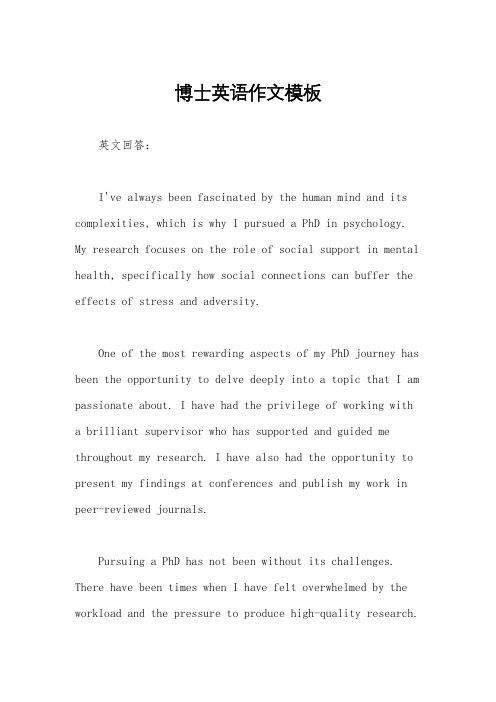
博士英语作文模板英文回答:I've always been fascinated by the human mind and its complexities, which is why I pursued a PhD in psychology. My research focuses on the role of social support in mental health, specifically how social connections can buffer the effects of stress and adversity.One of the most rewarding aspects of my PhD journey has been the opportunity to delve deeply into a topic that I am passionate about. I have had the privilege of working with a brilliant supervisor who has supported and guided me throughout my research. I have also had the opportunity to present my findings at conferences and publish my work in peer-reviewed journals.Pursuing a PhD has not been without its challenges. There have been times when I have felt overwhelmed by the workload and the pressure to produce high-quality research.However, I have learned to break down large tasks into smaller, more manageable ones. I have also learned to seek support from my supervisor, colleagues, and family.Through my PhD journey, I have not only developed a deep understanding of my research topic but also gained valuable transferable skills. I have become more proficient in critical thinking, problem-solving, and communication. I am also more confident in my abilities to conduct independent research and to present my findings to avariety of audiences.Ultimately, my goal is to use my PhD training to make a positive impact on the world. I hope to continue my research on the role of social support in mental health and to develop interventions that can help people to cope with stress and adversity. I also hope to mentor and inspire future generations of psychologists.中文回答:我一直对人类的心智及其复杂性着迷,因此我攻读了心理学博士学位。
英语毕业论文格式

英语毕业论文格式英语毕业论文一般采用APA格式。
以下是一个700字左右的英语毕业论文格式范例:Title of Your PaperYour NameYour Affiliation (University Name)Date of SubmissionAbstract:The abstract should summarize the main points of your paper in a concise and clear manner. It should be around 150 to 200 words, and should include a brief introduction, statement of the problem, methodology, major findings, and conclusion.Keywords: keyword 1, keyword 2, keyword 3Introduction:The introduction should provide the background information of the topic and present the research question or objective of your paper. It should also highlight the significance of the research and provide an overview of the structure.Literature Review:In this section, you will review the relevant literature on your topic. You should discuss previous studies and research findings related to your research question. It is important to provide a critique of the existing literature and identify any gaps that your study aims to address.Methodology:In the methodology section, you will explain the research design, sample size, data collection methods, and analysis techniques used in your study. Make sure to provide enough details for readers to understand and replicate your study if necessary.Results:Present the findings of your study in a clear and organized manner. Use graphs, tables, or other visuals to enhance the presentation of your results. Describe the major findings and discuss their implications.Discussion:In the discussion section, interpret your results and relate them back to your research question. Analyze the strengths and limitations of your study. Discuss the implications of your findings, suggest future research directions, and provide recommendations for practitioners.Conclusion:Summarize the main points of your paper and restate the significance of your research. Emphasize the contributions of your study and highlight the implications for theory and practice. References:List all the sources cited in your paper in APA format. Make sure to follow the proper citation style guidelines.Appendices:Include any supporting materials, such as survey instruments, interview questions, or additional data tables, in the appendices. Note: The word count for each section may vary depending on the requirements of your paper. Adjust the length accordingly while ensuring a balanced and coherent structure.。
浙大博士英语
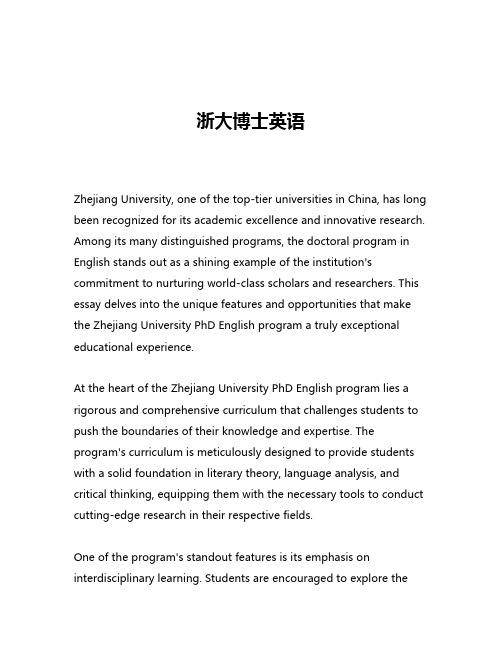
浙大博士英语Zhejiang University, one of the top-tier universities in China, has long been recognized for its academic excellence and innovative research. Among its many distinguished programs, the doctoral program in English stands out as a shining example of the institution's commitment to nurturing world-class scholars and researchers. This essay delves into the unique features and opportunities that make the Zhejiang University PhD English program a truly exceptional educational experience.At the heart of the Zhejiang University PhD English program lies a rigorous and comprehensive curriculum that challenges students to push the boundaries of their knowledge and expertise. The program's curriculum is meticulously designed to provide students with a solid foundation in literary theory, language analysis, and critical thinking, equipping them with the necessary tools to conduct cutting-edge research in their respective fields.One of the program's standout features is its emphasis on interdisciplinary learning. Students are encouraged to explore theintersections between English literature, linguistics, cultural studies, and other related disciplines, fostering a holistic understanding of the complexities of language and its sociocultural implications. This cross-pollination of ideas not only broadens the students' intellectual horizons but also enables them to approach research problems from multiple perspectives, ultimately leading to more innovative and impactful discoveries.The faculty at Zhejiang University's PhD English program are renowned scholars and researchers in their own right, bringing a wealth of expertise and experience to the classroom. These esteemed academics are not only dedicated teachers but also mentors who guide their students through the intricacies of academic research, helping them develop the critical thinking and analytical skills necessary to excel in their chosen fields.One of the hallmarks of the Zhejiang University PhD English program is its emphasis on hands-on research experience. Students are actively engaged in various research projects, collaborating with faculty members and fellow doctoral candidates to tackle complex research questions. This practical approach to learning allows students to apply the theoretical knowledge they have acquired, honing their research methodologies and problem-solving abilities.Moreover, the program's strong international focus further enhancesthe educational experience. Zhejiang University has forged partnerships with leading universities around the world, providing PhD English students with opportunities to participate in exchange programs, attend international conferences, and engage in collaborative research initiatives. This global perspective not only broadens the students' intellectual horizons but also equips them with the necessary skills to thrive in an increasingly interconnected world.Beyond the academic realm, the Zhejiang University PhD English program also fosters a vibrant and supportive community. Students benefit from a diverse and inclusive environment, where they can engage in lively discussions, share their research findings, and collaborate on interdisciplinary projects. This sense of community not only enriches the learning experience but also cultivates lasting professional and personal relationships among the program's participants.The program's commitment to excellence extends beyond the classroom as well. Zhejiang University's PhD English program boasts state-of-the-art facilities and resources, including well-equipped research laboratories, comprehensive library collections, and cutting-edge digital technologies. These resources, combined with the university's strong financial support and research funding, enable students to pursue their academic passions with the necessary toolsand resources at their disposal.Perhaps one of the most significant advantages of the Zhejiang University PhD English program is the opportunities it provides for professional development and career advancement. Graduates of the program are highly sought after by leading academic institutions, research organizations, and multinational corporations, thanks to their exceptional research skills, critical thinking abilities, and in-depth understanding of language and communication.Moreover, the program's strong industry connections and alumni network offer students valuable internship opportunities, collaborative research projects, and potential job prospects, ensuring a smooth transition from academia to the professional world. This seamless integration between the program's academic rigor and practical relevance is a testament to Zhejiang University's commitment to producing well-rounded and highly employable graduates.In conclusion, the Zhejiang University PhD English program stands out as a premier educational experience for aspiring scholars and researchers. Its comprehensive curriculum, world-class faculty, hands-on research opportunities, and global perspective, combined with a vibrant and supportive community, make it an exceptional choice for those seeking to pursue a doctoral degree in English. Asthe program continues to evolve and adapt to the changing demands of the academic and professional landscape, it remains a shining example of Zhejiang University's commitment to excellence and its unwavering dedication to nurturing the next generation of leaders and innovators in the field of English studies.。
浙江大学博士论文编写规则分析
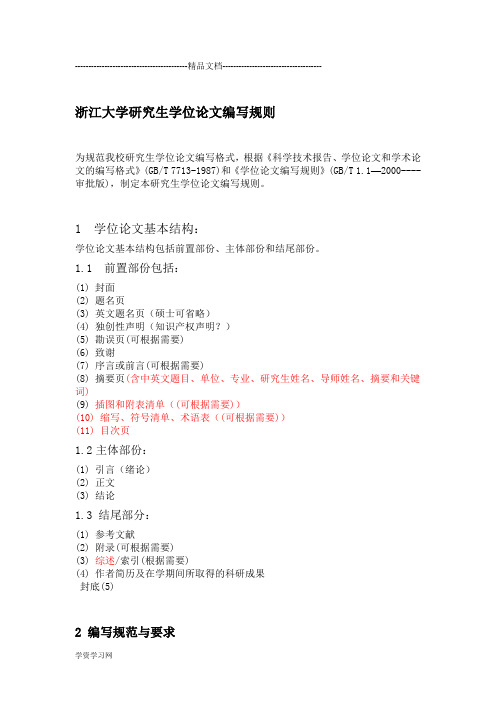
------------------------------------------精品文档-------------------------------------浙江大学研究生学位论文编写规则为规范我校研究生学位论文编写格式,根据《科学技术报告、学位论文和学术论文的编写格式》(GB/T 7713-1987)和《学位论文编写规则》(GB/T 1.1—2000----审批版),制定本研究生学位论文编写规则。
1 学位论文基本结构:学位论文基本结构包括前置部份、主体部份和结尾部份。
1.1 前置部份包括:(1) 封面(2) 题名页(3) 英文题名页(硕士可省略)(4) 独创性声明(知识产权声明?)(5) 勘误页(可根据需要)(6) 致谢(7) 序言或前言(可根据需要)(8) 摘要页(含中英文题目、单位、专业、研究生姓名、导师姓名、摘要和关键词)(9)插图和附表清单((可根据需要))(10) 缩写、符号清单、术语表((可根据需要))(11) 目次页1.2主体部份:(1) 引言(绪论)(2) 正文(3) 结论1.3 结尾部分:(1) 参考文献(2) 附录(可根据需要)(3) 综述/索引(根据需要)(4) 作者简历及在学期间所取得的科研成果封底(5)2 编写规范与要求2.1 前置部份2.1.1 封面:封面包括分类号、密级、单位代码、作者学号、校名、学校徽标、学位论文中文题目、英文题目、作者姓名、导师姓名、学科和专业名称、提交时间等内容(见附件1:学位论文封面样式)。
分类号:按中国图书分类法,根据学位论文的研究内容确定。
密级:仅限于涉密学位论文(论文课题来源于国防军工项目)填写,密级应根据涉密学位论文确定,分绝密、机密和秘密三级,并注明保密期限。
非涉密学位论文不得填写密级。
单位代码:10335。
作者学号:全日制和在职攻读专业学位者填写学号,同等学力申请学位人员填写申请号。
论文题目:应准确概括整个论文的核心内容,简明扼要,一般不能超过25个汉字,英文题目翻译应简短准确,一般不应超过150个字母,必要时可以加副标题。
浙江大学博士学位论文模板

密级:博士学位论文论文题目[博士论文标题]作者姓名 [作者]指导教师[导师] 教授、[导师] 教授[导师] 教授、[导师] 教授学科(专业) [学科名称]所在学院[学院名称]提交日期[时间]A Dissertation Submitted to ZhejiangUniversity for the Degree ofDoctor of PhilosophyTITLE:Author:Supervisor:Subject:College:Submitted Date:浙江大学博士学位论文摘要摘要[单击此处输入中文摘要]关键词:[单击此处输入中文关键词],[单击此处输入中文关键词]i浙江大学博士学位论文AbstractAbstract[Click here and input abstract in English]Keywords:[Click here and input keywords in English],[Click here and input keywords in English]ii浙江大学博士学位论文目录目录摘要 (i)Abstract (ii)第1章绪论 (1)1.1 课题背景 (1)1.1.1 (1)1.2 本章小结 (2)1.2.1 (2)第2章[单击此处输入标题,页眉会自动更新] (3)2.1 第一节 (3)2.1.1 (3)2.2 本章小结 (4)2.2.1 (4)第3章[单击此处输入标题,页眉会自动更新] (5)3.1 第一节 (5)3.1.1 (5)3.2 本章小结 (5)3.2.1 (5)第4章[单击此处输入标题,页眉会自动更新] (6)4.1 第一节 (6)4.1.1 (6)4.2 本章小结 (6)4.2.1 (6)第5章[单击此处输入标题,页眉会自动更新] (7)5.1 第一节 (7)5.1.1 (7)5.2 本章小结 (7)5.2.1 (7)第6章[单击此处输入标题,页眉会自动更新] (8)I浙江大学博士学位论文目录6.1 第一节 (8)6.1.1 (8)6.2 本章小结 (8)6.2.1 (8)第7章[单击此处输入标题,页眉会自动更新] (9)7.1 第一节 (9)7.1.1 (9)7.2 本章小结 (9)7.2.1 (9)第8章[单击此处输入标题,页眉会自动更新] (10)8.1 第一节 (10)8.1.1 (10)8.2 本章小结 (10)8.2.1 (10)参考文献 (11)攻读博士学位期间主要的研究成果 (12)致谢 (13)II浙江大学博士学位论文图目录图目录图1.1简单的语音信号多描述编解码过程 (2)图3.1 流程图 (5)III浙江大学博士学位论文表目录表目录表2.1简单的多描述分配表 (4)IV浙江大学博士学位论文第1章绪论第1章绪论1.1课题背景[单击此处输入论文正文]一般绪论中要把自己所做的工作放进去[1]。
博士学位论文答辩修改后定稿排版格式

博士学位论文答辩修改后定稿排版格式博士学位论文答辩修改后定稿排版格式1、版面大小A4纸2、正文字体小四号3、页边距上2.3、下2.0、左2.4、右2.34、页脚1.5cm5、页码注中间6、行距固定值18磅7、不设页眉内容8、每页排列39行×39列二、格式要求和有关说明:学位论文依次包括如下内容:封面、原创性声明和使用授权声明、致谢、摘要(中英文)、目录、前言、正文、结论、攻读学位期间发表的学术论文、参考文献。
1、论文题目:力求简短,一般不超过20个字,必要时可以使用副标题。
2、中文摘要:博士论文中文摘要一般1500字左右。
应说明研究目的、方法、成果和结论。
要突出论文的创造性成果或新的见解,语言力求精练。
关键词不超过5个。
3、英文摘要:英文摘要的上方应为论文题目(英文),换行居中写Abstract,英文摘要的内容与中文摘要基本相对应,要求语法正确,语句通顺,文字流畅。
4、参考文献:参考文献应按文中引用出现的顺序列出,可以附于各章末尾,也可以列在正文的末尾。
文献是期刊时,其格式为:(编号),作者(外文姓列名前),文章题目名,期刊名(外文可缩写),年份,卷号,期数,页码。
(若期刊无卷号,则为:年份,期号,页码)。
文献是图书时,其格式为:(编号),作者,书名,年份,版次(初版不写),出版单位,地点,页码。
特别在引用别人的科研成果时,应在引用处加以说明,避免论文抄袭现象的发生。
版面大小设置方法:文件菜单→页面设置·分类号必填学位代码必填U D C必填学校代码10298 密级必填学号必填填写说明:1.论文若同意网上公开交流,密级填:GK(“公开”首字母缩写);论文若只限校内使用,密级填:XZ(“限制”首字母缩写)封面密级要跟“原创性声明和使用授权声明”中填写一致2.封面上标注“必填”字样的字段,请认真查实后填写。
南京林业大学博士研究生学位论文论文题目:作者:专业:研究方向:指导教师:二○年月。
博士论文格式 英语
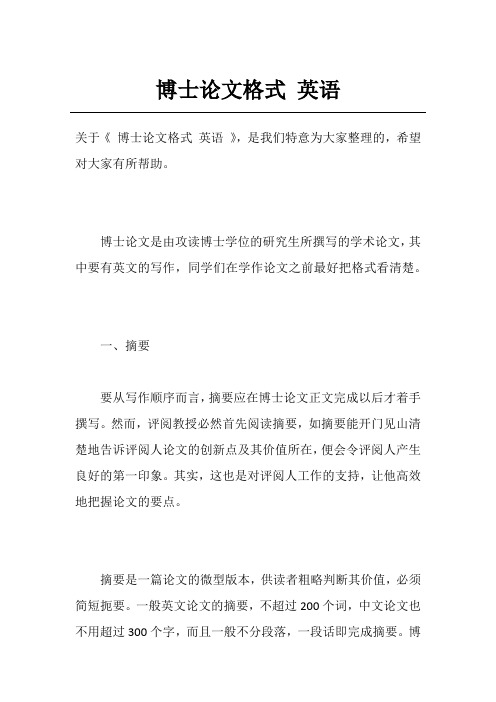
博士论文格式英语关于《博士论文格式英语》,是我们特意为大家整理的,希望对大家有所帮助。
博士论文是由攻读博士学位的研究生所撰写的学术论文,其中要有英文的写作,同学们在学作论文之前最好把格式看清楚。
一、摘要要从写作顺序而言,摘要应在博士论文正文完成以后才着手撰写。
然而,评阅教授必然首先阅读摘要,如摘要能开门见山清楚地告诉评阅人论文的创新点及其价值所在,便会令评阅人产生良好的第一印象。
其实,这也是对评阅人工作的支持,让他高效地把握论文的要点。
摘要是一篇论文的微型版本,供读者粗略判断其价值,必须简短扼要。
一般英文论文的摘要,不超过200个词,中文论文也不用超过300个字,而且一般不分段落,一段话即完成摘要。
博士论文摘要可分段,字数可多些,但800个中文字已足够。
摘要是向读者叙述本文的创新点和它的价值,一般采取陈述方式。
包含三个组成部分:(1)问题说明。
指明论文所要解决的问题,问题界定要清晰,并令读者意识到此问题的价值所在。
(2)创新点。
研究工作的贡献,即与众不同的新发现。
创新点应占去摘要中大部分篇幅。
(3)论证途径的说明。
创新点论证过程不必叙述,但作者若在论证方法技术上有改进和创新之处则可以写上。
几百个字把这些内容描述清楚,势必要用最精练、浓缩的语言。
在摘要写作中,值得注意的一些问题是:首先,引导性和支持性的解释应尽量少。
所谓引导性、支持性的解释内容包括研究历史回顾、文献综述和概念名词解释等。
其次,摘要不能写成目录式。
目录是告诉读者本文的内容,便于总览和查阅,而摘要是告诉读者自己做出了什么贡献。
如果摘要中按章再简介一遍内容,那就成为对目录的解释。
再次,摘要应采用学术语言表达创新点及其背景,让评阅人员和专业读者判断它的价值。
无论摘要或正文中都不能出现“销售论调”。
如作者自己写“本文有重大的理论和实用价值”等,这是学术论文很忌讳的事情。
最后,研究生论文摘要中常易出现一个毛病,即在归纳论文的创新点时,只说“做了”或“研究了”什么,而不说“做出了”、“研究出了”什么,一字之差,相距甚远。
英语专业毕业论文格式说明

学位论文格式说明选题范围要求:语言与语言学;英美文学与比较文学;语言教学;翻译理论与实践;英语国家文化与跨文化交际;国际关系与国际政治。
一、毕业论文格式规范论文基本结构和要求:除中文摘要外,论文其余部分一律用英文撰写,所引文献采用美国心理协会的引用和文献单格式,即APA Style。
具体格式请参见论文样稿。
1.封面:由外语学院统一提供。
用汉语填写所有内容(论文题目用英语)。
2.扉页:论文中文和英文首页各一版,规范格式由外语学院提供。
3.论文提纲:格式及要求由外语学院提供。
4.摘要:又称内容提要,应以浓缩的形式概括研究课题的内容、方法和观点以及取得的成果和结论,应能反映整个毕业论文的精华内容。
中文和英文摘要都以300-500字为宜。
撰写摘要时应注意以下几点:(1)用精炼、概括的语言来表达,每项内容不宜展开论证或说明;(2)要客观陈述,不宜加主观评价;(3)成果和结论性字句是摘要的重点,在文字论述上要多些,以加深读者的印象;(4)要独立成文,选词用语要避免与全文尤其是前言和结论部分雷同;英文摘要:包括(1)Abstract;(2)摘要内容;(3)3-5个关键词,排在摘要内容的左下方,关键词之间用逗号隔开,e.g. Keywords:…。
中文摘要:将英文摘要译成中文,包括:(1)摘要(加粗);(2)摘要内容;(3)3-5个关键词,排在摘要内容的左下方,关键词之间用逗号隔开。
例如:关键词:… …。
5.正文:(1)长度不少于4000个单词,一般4000-6000单词;注释采用文中夹注形式。
(2)每章另起一页。
6.注释:在正文中用括号标明引语的作者和页码(具体规范见论文样稿)。
7.参考文献(Bibliography):中英文参考书目要分开,英文书目在前,中文书目在后。
参考书目要标明作者、出版时间、书名(或文章题目)、出版单位等。
英文书目和中文书目都应按照英语字母顺序排列。
中文文献顺序按作者或编者姓氏的汉语拼音英文字母顺序排列。
英语毕业论文的格式范文
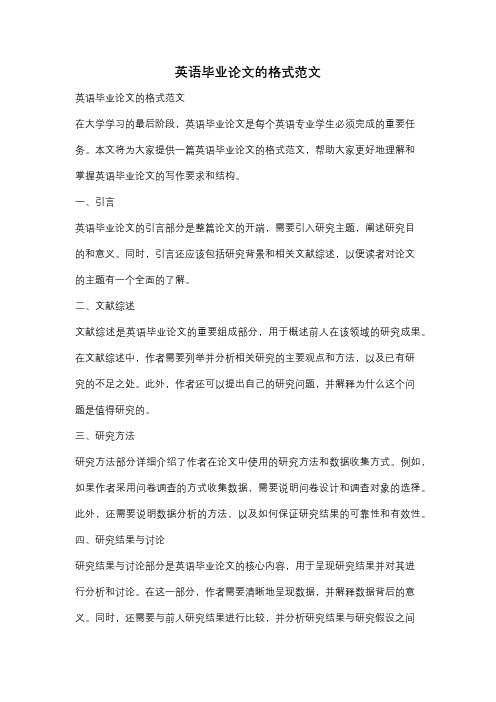
英语毕业论文的格式范文英语毕业论文的格式范文在大学学习的最后阶段,英语毕业论文是每个英语专业学生必须完成的重要任务。
本文将为大家提供一篇英语毕业论文的格式范文,帮助大家更好地理解和掌握英语毕业论文的写作要求和结构。
一、引言英语毕业论文的引言部分是整篇论文的开端,需要引入研究主题,阐述研究目的和意义。
同时,引言还应该包括研究背景和相关文献综述,以便读者对论文的主题有一个全面的了解。
二、文献综述文献综述是英语毕业论文的重要组成部分,用于概述前人在该领域的研究成果。
在文献综述中,作者需要列举并分析相关研究的主要观点和方法,以及已有研究的不足之处。
此外,作者还可以提出自己的研究问题,并解释为什么这个问题是值得研究的。
三、研究方法研究方法部分详细介绍了作者在论文中使用的研究方法和数据收集方式。
例如,如果作者采用问卷调查的方式收集数据,需要说明问卷设计和调查对象的选择。
此外,还需要说明数据分析的方法,以及如何保证研究结果的可靠性和有效性。
四、研究结果与讨论研究结果与讨论部分是英语毕业论文的核心内容,用于呈现研究结果并对其进行分析和讨论。
在这一部分,作者需要清晰地呈现数据,并解释数据背后的意义。
同时,还需要与前人研究结果进行比较,并分析研究结果与研究假设之间的关系。
五、结论结论部分对整个论文进行总结,并提出对未来研究的建议。
在结论中,作者需要回顾研究目的和研究问题,并总结自己的研究成果。
此外,作者还可以讨论研究的局限性,并提出进一步研究的方向。
六、参考文献参考文献部分是英语毕业论文的最后一部分,用于列举作者在论文中引用的所有文献。
在参考文献中,作者需要按照一定的格式规范列出文献的作者、题目、出版年份等信息,以便读者可以查找和阅读相关文献。
总结:以上是一篇英语毕业论文的格式范文,希望能对大家在写作英语毕业论文时提供一些参考。
当然,在实际写作过程中,还需要根据具体的研究主题和要求进行调整和完善。
最重要的是,要保持逻辑清晰、语言准确,并注重数据的分析和解释,以确保论文的质量和可信度。
关于博士、硕士学位论文统一格式的有关规定
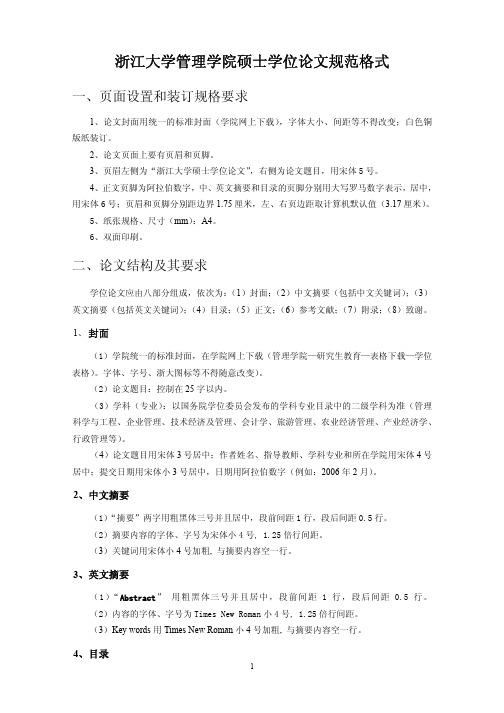
浙江大学管理学院硕士学位论文规范格式一、页面设置和装订规格要求1、论文封面用统一的标准封面(学院网上下载),字体大小、间距等不得改变;白色铜版纸装订。
2、论文页面上要有页眉和页脚。
3、页眉左侧为“浙江大学硕士学位论文”,右侧为论文题目,用宋体5号。
4、正文页脚为阿拉伯数字,中、英文摘要和目录的页脚分别用大写罗马数字表示,居中,用宋体6号;页眉和页脚分别距边界1.75厘米,左、右页边距取计算机默认值(3.17厘米)。
5、纸张规格、尺寸(mm):A4。
6、双面印刷。
二、论文结构及其要求学位论文应由八部分组成,依次为:(1)封面;(2)中文摘要(包括中文关键词);(3)英文摘要(包括英文关键词);(4)目录;(5)正文;(6)参考文献;(7)附录;(8)致谢。
1、封面(1)学院统一的标准封面,在学院网上下载(管理学院—研究生教育—表格下载—学位表格)。
字体、字号、浙大图标等不得随意改变)。
(2)论文题目:控制在25字以内。
(3)学科(专业):以国务院学位委员会发布的学科专业目录中的二级学科为准(管理科学与工程、企业管理、技术经济及管理、会计学、旅游管理、农业经济管理、产业经济学、行政管理等)。
(4)论文题目用宋体3号居中;作者姓名、指导教师、学科专业和所在学院用宋体4号居中;提交日期用宋体小3号居中,日期用阿拉伯数字(例如:2006年2月)。
2、中文摘要(1)“摘要”两字用粗黑体三号并且居中,段前间距1行,段后间距0.5行。
(2)摘要内容的字体、字号为宋体小4号, 1.25倍行间距。
(3)关键词用宋体小4号加粗, 与摘要内容空一行。
3、英文摘要(1)“Abstract” 用粗黑体三号并且居中,段前间距1行,段后间距0.5行。
(2)内容的字体、字号为Times New Roman小4号, 1.25倍行间距。
(3)Key words用Times New Roman小4号加粗, 与摘要内容空一行。
4、目录(1)“目录” 两字用粗黑体三号并且居中,段前间距1行,段后间距0.5行。
英语论文格式规范

英语论文格式规范第一篇:英语论文格式规范外国语学院英语论文格式规范(附样例)A Contrastive Study between English and Chinese Idioms(题目:二号,黑体,加粗,居中,除了英语小词外,其他单词首字母都要大写;另外:除了题目外,论文中所有英文的字体均采用“Times New Roman”)外国语学院2001级英语教育1030120011XXXXX指导老师:XXX(学院、专业、学号、作者姓名、指导教师姓名(小四号宋体字,加粗),依次排印在论文题目下,上空二行,居中)【Abstract】 This paper centers on the different expressions of ……(英文摘要:上空二行;题目采用五号“Times New Roman”字体,加粗,置于粗体方括号【】内,顶格放置;随后的内容与前面的粗体方括号【】之间空一格,不用其他任何标点符号;采用五号“Times New Roman”字体,不加粗;单倍行距。
)【Key Words】idiom;comparison;English;Chinese(英文关键词:题目采用五号“Times New Roman”字体,加粗,两个单词的首字母要大写,置于粗体方括号【】内,顶格放置;随后的内容与前面的粗体方括号【】之间空一格,不用任何其他标点符号,采用五号“Times New Roman”字体,不加粗,除了专有名词外,其他单词的首字母不大写,各单词之间用分号“;”隔开,分号之后空一格;最后一个关键词之后不用任何标点符号;单倍行距。
)1.Introduction(顶格,除了第一个单词及专有名词外,其他单词首字母都不要大写;标题最后不用任何标点符号,上空两行)In both English and Chinese, ….So, this essay is trying tofocus on the differences between Chinese and English idoms in terms of their essential meaning, customary usage and typical expression(Chang Liang, 1993:44;Li Guangling, 1999).(段落第一行缩进4个英文字符;夹注的标注法:出现在夹注中的作者必须与文后的参考文献形成一一对应关系;注意一个或多个作者间的标点符号,时间、页码等的标注法;另外,汉语参考文献的作者要以拼音形式出现,不能出现汉语姓氏;夹注出现在标点符号之前)2.The similarities between English idioms and Chinese idiomsIn English, ….And it can be clearly seen in the below examples:(1)I don’t know。
考博博士英语作文模板

考博博士英语作文模板英文回答:The Significance of Scientific Research and the Role of Universities in Fostering Innovation。
Scientific research is the systematic inquiry that seeks to establish new knowledge about the natural and social world. It is a fundamental driver of progress and innovation, leading to advancements in various fields such as medicine, technology, and agriculture. Universities, as centers of higher learning and research, play a pivotalrole in fostering innovation by providing a fertile environment for the creation and dissemination of new knowledge.Universities offer a unique ecosystem that brings together talented researchers, state-of-the-art facilities, and a collaborative research culture. Researchers in universities have the freedom to explore new ideas, engagein interdisciplinary collaborations, and conduct cutting-edge experiments that push the boundaries of human knowledge. This freedom allows for groundbreaking discoveries and the development of innovative technologies that have the potential to transform society.Moreover, universities provide a platform for the dissemination of research findings through publications, conferences, and seminars. By sharing their research with the broader academic community and the public, universities contribute to the advancement of knowledge and stimulate further innovation. The open exchange of ideas and the critical evaluation of research foster a culture of intellectual inquiry and creativity that is essential for scientific progress.In addition, universities play a crucial role in training future researchers and innovators. Through graduate programs and postdoctoral fellowships,universities provide students with the skills and knowledge necessary to conduct independent research and contribute to the scientific community. These highly trained researchersgo on to work in academia, industry, and government, where they apply their expertise to solve complex problems and drive innovation.Furthermore, universities actively engage with industry and government to facilitate the translation of research findings into practical applications. Through partnerships and collaborations, universities provide expertise and resources to support innovation in the private sector and contribute to the development of new products, services,and processes. This collaboration not only benefitsindustry but also generates funding for university research, further supporting the cycle of innovation.In conclusion, scientific research is a vital force driving progress and innovation across multiple disciplines. Universities, with their unique ecosystem of researchers, facilities, and collaborative culture, play anindispensable role in fostering innovation by creating, disseminating, and applying new knowledge. Through their commitment to research, training, and engagement with industry and government, universities contributesignificantly to the advancement of science and the transformation of society.中文回答:科学研究的重要性及高校在促进创新中的作用。
博士英语作文写信的格式

博士英语作文写信的格式Title: The Format of Writing a Letter in English for Doctoral English Composition。
Dear [Recipient's Name],。
I hope this letter finds you well. I am writing to you to inquire about [state the purpose of the letter]. As a doctoral student in English, I am keen on following the appropriate format for writing letters in English. Below, I have outlined the key components and format that should be adhered to when writing a letter in English:1. Sender's Address: This should be placed at the top right-hand corner of the letter. It should include yourfull name, your street address, city, state, and zip code. For example:[Your Name][Your Street Address][City, State, Zip Code]2. Date: The date should be written below your address, aligned to the left. It is typically written in full, for example: May 2, 2024.3. Recipient's Address: Below the date, you should include the recipient's full name, their title (if applicable), the name of the organization (if sending to a company or institution), their street address, city, state, and zip code. For example:[Recipient's Name][Recipient's Title, if applicable][Name of Organization, if applicable][Recipient's Street Address][City, State, Zip Code]4. Salutation: Begin the letter with a formal salutation. If you know the recipient's name, use "Dear [Recipient's Name],". If you do not know their name, you can use a general salutation such as "Dear Sir/Madam," or "To Whom It May Concern,".5. Body: The body of the letter should be single-spaced with a blank line between paragraphs. It should be concise, clear, and address the purpose of the letter. Each paragraph should focus on a single idea and flow logically from one to the next.6. Closing: End the letter with a formal closing, such as "Sincerely," or "Yours faithfully," followed by a comma. Leave four lines after the closing to handwrite your signature if sending a physical letter.7. Signature: If sending a physical letter, sign your name in the space between the closing and your typed name. If sending an email, you can include a digital signature ifdesired.8. Typed Name: Below your signature, type your full name.9. Enclosures: If you are including any additional documents with the letter, such as a CV or references, you should list them below your typed name. For example: "Enclosures: CV, References".10. Subject Line (for email): If sending the letter via email, include a clear and concise subject line that summarizes the purpose of the letter.I hope this guide helps you in formatting your letters in English. If you have any further questions or need clarification on any of the points mentioned above, please feel free to reach out to me.Sincerely,。
毕业论文英文的格式范文大全

英语论文的格式是什么4.5、正文结构与格式的统一规定:正文内容一般包括前言、论文主体和结论。
正文内分级小标题力求简明,文章层次不宜过多,一般不超过3个层次。
文章分级小标题占一行,必须采用以下格式的序号来表明文章的层次(同一层次的序号和标题必须对整齐)。
正文的题目:使用Times New Roman 16号字,黑体;正文一级标题使用Times New Roman14号字黑体;二级标题使用Times New Roman13号字黑体;三级标题使用Times New Roman 12号字斜体。
正文的内容:要求使用Times New Roman 12号字打印。
论文页面设置:左边距为3.70厘米,右边距占3.00厘米,上下边距各占2.50厘米。
空格:段首句空四个字符;每个单词之间只能空一格。
行距:段落间距为2.0倍,正文行距为1.5倍。
P.S.太多了,给我百度Hi~我发邮件给你。
英文论文的详细格式英文论文的详细格式二、提纲英语论文提纲页包括论题句及提纲本身,其规范格式如下:先在第一行(与打印纸顶端的距离仍为2.5cm左右)的始端打上 Thesis 一词及冒号,空一格后再打论题句,回行时左边须与论题句的第一个字母上下对齐。
主要纲目以大写罗马数字标出,次要纲目则依次用大写英文字母、阿拉伯数字和小写英文字母标出。
各数字或字母后均为一句点,空出一格后再打该项内容的第一个字母;处于同一等级的纲目,其上下行左边必须对齐。
需要注意的是,同等重要的纲目必须是两个以上,即:有Ⅰ应有Ⅱ,有A应有B,以此类推。
如果英文论文提纲较长,需两页纸,则第二页须在右上角用小写罗马数字标出页码,即ii(第一页无需标页码)。
三、摘要 1、英文摘要是应用符合英文语法的文字语言,提供论文内容梗概为目的的短文。
(内容基本与中文摘要相同,但不用完全逐句对应)。
2、英文题目、摘要、关键词自成一页(1页即可),放在中文摘要页之后。
3、英文字体与行间距:统一使用“西文字体”中的“Times New Roman”,1.5倍行间距。
- 1、下载文档前请自行甄别文档内容的完整性,平台不提供额外的编辑、内容补充、找答案等附加服务。
- 2、"仅部分预览"的文档,不可在线预览部分如存在完整性等问题,可反馈申请退款(可完整预览的文档不适用该条件!)。
- 3、如文档侵犯您的权益,请联系客服反馈,我们会尽快为您处理(人工客服工作时间:9:00-18:30)。
浙江大学外语学院英文版博士学位论文格式1.1用纸与页面设置论文采用A4号纸,单面印或双面印均可。
页面设置的页边距为:左3.2厘米,上、下、右各2.5厘米。
装订线为1厘米。
如双面印,需适当调整装订线,避免反面的内容距离装订线过近。
1.2 组成部分(1)中文封面(模板见附录1a)(2)英文标题页(Title page,模板见附录1b)(3)中文题名页(模板见附录2a)(4)英文题名页(模板见附录2b)(5)学位论文书脊(模板见附录3)(6)学位论文版权使用授权书和独创性声明(Authorization of copyright and declaration about the originality of the thesis/dissertation,模板见附录4)(7)中文摘要(Chinese abstract)(8)英文摘要(Abstract)(9)致谢(Acknowledgements)(10)目录(Contents,样本模板见附录5-6)(11)图目(Figures,如正文中有图)(12)表目(Tables,如正文中有表)(13)缩略语表(Abbreviations,非必须)(14)正文(Text)(15)附录(Appendices,非必须)(16)参考文献(References,样本见附录7)(17)索引(Index,非必须)2前辅文(Front matter)2.1论文标题论文标题应尽量简明、具体。
2.2 中文摘要归纳论文论证的主要观点或做出的主要发现。
长度不少于5000汉字(学校规定用英文写博士学位论文必须有不少于5000汉字的中文摘要)。
标题字体为宋体三号加粗,正文字体为宋体小四。
行距为2倍。
摘要中不应出现图表。
2.3英文摘要(Abstract)长度不超过1页(约350词)。
标题字体为Times New Roman 18 bold,正文字体为Times New Roman 12。
行距为1.5倍。
摘要中不应出现图表。
2.4 致谢(Acknowledgements)语言与正文一致。
长度一般不超过1页。
标题字体为Times New Roman 18 bold,正文字体为Times New Roman 12。
行距为2倍。
2.5目录(Contents)目录的内容和语言与正文的章标题、节标题和小节标题一致。
如章、节、小节的标题仅以阿拉伯数字为序号,目录的所有标题均顶左页边起头,标题页码右对齐(样本模板见附录3)。
如章标题的序号采用Chapter n的形式,仅章标题顶左页边起头。
节标题和小节标题,缩进1厘米,标题页码右对齐(样本模板见附录4)。
目录本身标题居中,字体为Times New Roman 18 bold。
目录正文的字体为Times New Roman 12。
章标题使用bold。
行距为1.5倍或其固定值设置为20磅。
目录标题与目录正文之间空2行,文前部分标题与正文标题之间、两章的标题之间以及正文标题与附录和参考文献的标题之间各空1行。
目录样本模板见附录3-4。
12.6 图目(Figures)内容和语言与正文中的图名一致。
标题(caption)字体为Times New Roman 18 bold,正文字体为Times New Roman 12。
行距为1.5倍。
2.7表目(Tables)内容和语言与正文中表的名称一致。
标题字体为Times New Roman 18 bold,正文字体为Times New Roman 12。
行距为1.5倍。
2.8缩略语表(Abbreviations)如正文中使用的缩略语较多,可制作一缩略语表,分双栏排列,左栏为缩略语,右栏为与之对应的全称。
标题字体为Times New Roman 18 bold,正文字体为Times New Roman 12。
行距为1.5倍。
2.9 页码1该样本的格式可直接套用。
论文从英文标题页(title page)起到正文前的最后一页属于文前部分(front matter)。
论文文前部分的页码用小写罗马数字编号。
从论文正文的首页到全部论文最后一页的页码用阿拉伯数字编号。
从1到20的小写罗马数字及对应的阿拉伯数字如下:i ii iii iv v vi vii viii ix x1 2 3 4 5 6 7 8 9 10xi xii xiii xiv xv xvi xvii xviii xix xx11 12 13 14 15 16 17 18 19 203正文(Text)3.1结构层次正文分为若干章(chapter),每章另起一页。
每章分为若干节(section),每节可分为若干小节(subsection)。
节与节之间、小节与小节之间空1行。
3.2标题章标题独占一行,居中。
章号可以采用纯阿拉伯数字或“Chapter n”的形式。
章号后空1格,不加顿号或小数点,然后是章标题。
章号及章标题的字体为Times New Roman 18 bold,句首和句末词的首字母以及句中实词(含代词)的首字母大写。
节标题独占一行。
如章号采用“Chapter n”的形式,节标题起头空2字符或1厘米;如章号采用纯阿拉伯数字,则节标题顶左页边起头。
节号为阿拉伯数字。
节号的形式为1.1、1.2、1.3。
节号后空1格,不加顿号或小数点,然后是节标题。
章号及章标题的字体为Times New Roman 12 bold,句首词的首字母大写。
小节标题独占一行。
如节标题缩进,小节标题也同样缩进,否则顶左页边起头。
小节号为阿拉伯数字。
小节号的形式为1.1.1、1.1.2、1.1.3。
小节号后空1格,不加顿号或小数点,然后是小节标题。
小节号及小节标题的字体为Times New Roman 12 bold,句首词的首字母大写。
小节之下可以采用字母A. B. C.,a. b. c.,(a) (b) (c)或罗马数字I. II. III.,i. ii. iii.,(i) (ii) (iii) 对需要编号的内容加以编号。
3.3字体正文的默认字体为Times New Roman 12。
英文倾斜字体(italics)的使用范围主要是:(1)词作为词本身使用,如:The most frequently used word in English is the.(2)拼写尚未被普遍接受的外来词,如:Jiaozi is a very popular food in China.(3)书刊等的名称。
图表的字体可根据需要换为较小的字号。
3.4行距正文的默认行距为2倍。
图表的行距为单倍。
章标题与正文之间空1行,节标题与正文之间、小节标题与正文之间不空行。
图表与正文之间上下各空1行。
3.5图表(Figures and tables)图标题置于图的下方,表标题置于表的上方。
图表标题连同图表顶左页边起头,图表标题与图表之间不空行。
每章的图表单独编号,图号的格式为“图+阿拉伯数字”,表号的格式为“表+带小数点的阿拉伯数字”。
小数点前的数字为章号,之后的数字为图表本身的序号。
图表号与图表标题之间空1格。
图表标题与图表之间不空行。
图表的字体一般为Times New Roman 12;如果需要,可以适当采用较小的字号。
图表的行距为1.5倍。
3.6参引(Parenthetical reference/citation)一切直接或间接引文以及论文所依据的文献均须通过随文圆括号参引(in-text parenthetical reference)标明其出处。
参引的内容和语言须与正文之后所列参考文献的内容和语言一致。
文献上所署的作者名字如果是中文本名,参引时引其全名;如果是朝鲜/韩国、越南、日本名字的中文译名,参引时比照中文名字;如果是英文名字的中文译名,即使该译名使用了中文的姓氏,如“韩礼德”(M.A.K. Halliday),参引时也仅引其姓,不引其全名,除非参考目录里有两个同姓的作者。
作者名字如果是英文或汉语拼音,不论该名字是本名还是译名,参引时都仅引其姓。
其他民族的名字或其译名如果类似英文名字,参引时比照英文名字。
转述某作者或某文献的基本或主题观点或仅提及该作者或该文献,只需给出文献的出版年,如:陈前瑞(2003)认为,汉语的基本情状体分为四类,即状态、活动、结束、成就。
直接或间接引述某一具体观点,须给出文献的页码,格式是“出版年:页码”2,如:2注意:中文参引使用中文字体的冒号,后面不空格;英文参引使用英文字体的冒号,后面空格。
吕叔湘(2002:117)认为,成做动词时,有四个义项:1) 成功、完成;2) 成为;3)可以、行;4) 能干。
如作者的名字不是正文语句的一个成分,可将之连同出版年、页码一起置于圆括号内,如:这是社交语用迁移的影响,即“外语学习者在使用目的语时套用母语文化中的语用规则及语用参数的判断”(何兆熊 2000:265)。
圆括号内的参引如果不止一条,一般按照出版年排序。
同一作者的两条参引之间用逗号隔开,如:Dahl (1985, 2000a, 2000b );不同作者的参引之间用分号隔开,如:In addition to these three well recognized aspectual markers, some scholars (王力1985; 戴耀晶1997; 吕叔湘2004; Xiao & McEnery 2004) have also studied the aspectual meanings of qilai (起来) and xiaqu (下去).文献作者如果是两个人,参引时引两个人的名字。
格式是在两个姓之间加&号,表示‘和’,如Li & Thompson (1981)3。
文献作者如果是三人或三人以上,参引时仅引第1作者的名字。
格式是在第1作者的姓之后加拉丁缩略语“et al.”,表示‘和他人’,如“Quirk et al. (1985)”,et al.不必是斜体。
同一篇文献如果有不同版本(edition),而论文作者参引的是后来的版本,一般应在参引中给出第1版及作者参引版的出版年,二者中间加/号,如:Alexander Schmidt编纂的两卷本巨著Shakespeare Lexicon and Quotation Dictionary(1874/1902/1971)同一版本不同年代的印本(reprint),参引时一般不必特别标明,除非作者需要参引某一印本文前部分的内容。
在参引外文文献的中文译本时,一般应同时给出原文版本和译本的出版年。
3.7注释(Notes)注释是对论文的某一内容或形式作进一步说明或解释,这种说明或解释如果放在正文中会妨碍文本的连贯。
注释一般采用随文圆括号夹注(in-text parenthetical note)或脚注(footnote)的形式。
